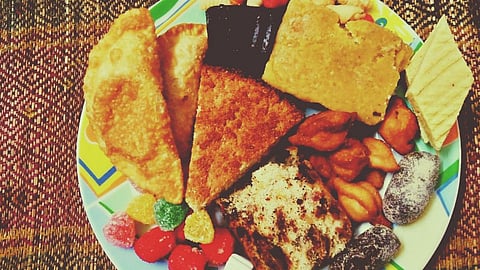

No Goan Christmas consoada or kuswar is complete without nevreos
Arti Das
What’s the easiest way to know that Christmas is just around the corner? Just step out in your verandah, and you will immediately be enveloped in the mouth-watering neighbourhood aromas of baking cakes and other delicious items that make a flavourful Christmas.
The Christmas consoada or kuswar — a platter of sweets and savouries which is distributed to friends and neighbours on the eve, or on the day, of Christmas in many ways symbolizes the Christmas festivity. This platter is very colourful and has vibrant goodies in different shapes, sizes and obviously flavours. Most of these items are made at home and are traditional Goan sweets.
SWEET FILLINGS
Food historian, Fatima da Silva Gracias, in her book, Cozinha de Goa, while speaking about traditional sweets made during Christmas in Goa mentions, “The most popular were the sweets made at home with rice flour, coconut, semolina, channa dal (Bengal dal) and palm jaggery.”
Interestingly, most of these ingredients are required to make a special Goan sweet—nevreos.
This is a deep fried pastry, stuffed with various fillings. In Goa, they are an essential item not only at Christmas, but also during the Hindu festival of Ganesh Chaturthi (celebrated either in the month of August or September), weddings or Shigmo, which happens every March.
One may wonder what this sweet is all about. To draw parallels, it is similar to the North Indian sweet dish, gujia, sans the sugar syrup. Also, unlike gujia, the pastry of nevreos is flaky and thin.
It is made up of different stuffings, right from desiccated coconut, infused with dry fruits, to toasted gram flour, as well as the spicy versions of these.
Nevreos contain a variety of fillings
Arti Das
Making these nevreos is a lengthy process that begins well before the festivities. It begins with sun-drying the grated coconut, preparing ingredients, etc. Also, it is not a one-person activity because one person has to roll the pastry, another adds the filling and yet another does the frying. All these steps need to be perfect so as to obtain scrumptious nevreos.
Many a time, it is assumed that the nevreos made for Christmas are different from the ones made during Chaturthi. However, there’s no difference!
Jacqueline Fernandes, owner of Jacques Bakes, Merces, says, “There is no difference at all. If one has to point out the difference, it could be the recipe of the filling, based on family traditions. So, every family will have a different recipe of fillings.”
Philomena Rodrigues, from St. Cruz, agrees, adding that she also focuses on fillings. “The only difference is fillings, and that depends on each family. We use mostly desiccated coconut, rawa, poppy seeds and dry fruits. Besides, I have come across more traditional fillings, which are prepared by boiling jaggery and then adding fresh coconut and cardamom to it. It is similar to a patoli filling. Nowadays, we use that coconut-rawa filling as it lasts longer.”
Speaking of fillings for the pastry, Fernandes elaborates that the common fillings used to make nevreos are — coconut and sugar; coconut and rawa/semolina; moog dal and sugar powder; chana dal and sugar powder.
GLOBAL FLAVOUR
One may wonder how this sweet-savoury preparation became part of the Christmas consoada. Gracias states in her book, “Goa’s Christmas sweets had a global touch long before the age of globalization! Christmas confectionery, here, draws from diverse cultures—Portuguese, Hindu, Arabic, Malaysian and Brazilian. The Hindu “food of the gods” had its influence on Christmas confectionery in the form of nevreos, kulkuls and shankarpalis.”
Whatever the reason—the fact is that one gets a chance to savour the nevreos not once, but twice, in a year in Goa. This festive dish is no less than a symbol of communal harmony and the deep bond we share with diverse people.
So, let’s celebrate this with some nevreos, and other equally delicious sweets, and spread the message of amity this Christmas.
Merry Christmas!